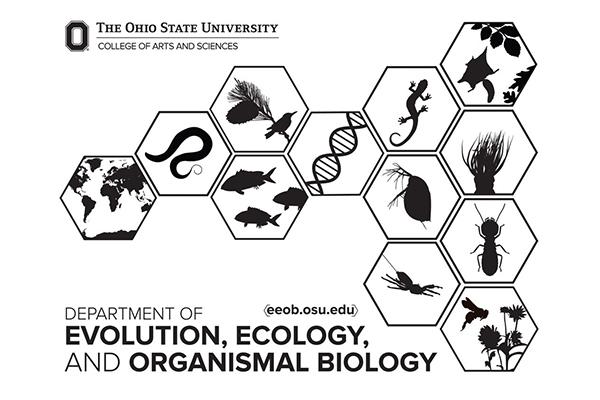EEOB Publications January 1 - January 31

Single and combined abiotic stressors affect maize rhizosphere bacterial microbiota
Rosa Vescio, Antonino Malacrinò, Alison E. Bennett, Agostino Sorgonà. 2021. DOI: 10.1016/j.rhisph.2021.100318
Abstract
Rhizosphere microbiomes are influenced by abiotic stresses, but we know a little about their response to combinations of stresses. In this study we tested: (i) if drought and heat stress influence the maize rhizosphere microbial community; (ii) if the combination of drought and heat has a different outcome compared to a single stress; (iii) if rhizosphere microbiota clusters according to root class and root zone. We setup a microcosm system using maize as model plant. We exposed plants to drought, heat stress and their combination, and used 16S amplicon-sequencing to reconstruct bacterial communities of different root classes (crown and primary) and root zones (apical, sub-apical and basal). We found both drought and heat affect the structure of rhizosphere bacterial communities. The combination of these stressors also influenced the structure of rhizosphere microbial communities, but this effect did not differ compared to the single stresses. Interestingly, we found differences in microbial communities inhabiting the rhizosphere of crown and primary roots in the control treatment, but this difference disappeared once stresses were applied. Stress also lead to an increased abundance of beneficial organisms.
ROS and hypoxia signaling regulate periodic metabolic arousal during insect dormancy to coordinate glucose, amino acid, and lipid metabolism
Chao Chen, Rohit Mahar, Matthew E. Merritt, David L. Denlinger, and Daniel A. Hahn. 2021. 118 (1) e2017603118; DOI: 10.1073/pnas.2017603118
Abstract
Metabolic suppression is a hallmark of animal dormancy that promotes overall energy savings. Some diapausing insects and some mammalian hibernators have regular cyclic patterns of substantial metabolic depression alternating with periodic arousal where metabolic rates increase dramatically. Previous studies, largely in mammalian hibernators, have shown that periodic arousal is driven by an increase in aerobic mitochondrial metabolism and that many molecules related to energy metabolism fluctuate predictably across periodic arousal cycles. However, it is still not clear how these rapid metabolic shifts are regulated. We first found that diapausing flesh fly pupae primarily use anaerobic glycolysis during metabolic depression but engage in aerobic respiration through the tricarboxylic acid cycle during periodic arousal. Diapausing pupae also clear anaerobic by-products and regenerate many metabolic intermediates depleted in metabolic depression during arousal, consistent with patterns in mammalian hibernators. We found that decreased levels of reactive oxygen species (ROS) induced metabolic arousal and elevated ROS extended the duration of metabolic depression. Our data suggest ROS regulates the timing of metabolic arousal by changing the activity of two critical metabolic enzymes, pyruvate dehydrogenase and carnitine palmitoyltransferase I by modulating the levels of hypoxia inducible transcription factor (HIF) and phosphorylation of adenosine 5′-monophosphate-activated protein kinase (AMPK). Our study shows that ROS signaling regulates periodic arousal in our insect diapasue system, suggesting the possible importance ROS for regulating other types of of metabolic cycles in dormancy as well.
Pedigree-based assessment of recent population connectivity in a threatened rattlesnake
Scott Martin, Greg Lipps, H. Lisle Gibbs. 2021. Authorea. DOI: 10.22541/au.161125642.28501978/v1
Abstract
Managing endangered species in fragmented landscapes requires estimating dispersal rates between populations over contemporary timescales. Here we develop a new method for quantifying recent dispersal using genetic pedigree data for close and distant kin. Specifically, we describe an approach that infers missing shared ancestors between pairs of kin in habitat patches across a fragmented landscape. We then apply a stepping-stone model to assign unsampled individuals in the pedigree to probable locations based on minimizing the number of movements required to produce the observed locations in sampled kin pairs. Finally, we use all pairs of reconstructed parent-offspring sets to estimate dispersal rates between habitat patches under a Bayesian model. Our approach measures connectivity over the timescale represented by the small number of generations contained within the pedigree and so is appropriate for estimating the impacts of recent habitat changes due to human activity. We used our method to estimate recent movement between newly discovered populations of threatened Eastern Massasauga Rattlesnakes (Sistrurus catenatus) using data from 2996 RAD-based genetic loci. Our pedigree analyses found no evidence for contemporary connectivity between five genetic groups, but, as validation of our approach, showed high dispersal rates between sample sites within a single genetic cluster. We conclude that these five genetic clusters of Eastern Massasauga Rattlesnakes have small numbers of resident snakes and are demographically isolated conservation units. More broadly, our methodology can be widely applied to determine contemporary connectivity rates, independent of bias from shared genetic similarity due to ancestry that impacts other approaches.
